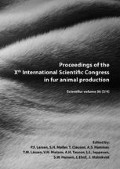Abstract
In the middle of May 2011 three farms in the Netherlands claimed increase of mortality of the young pups round the age of 15 days old. The three farms were scattered over The Netherlands. Employees of the diseased farms even as the farmer and his family were suffering from influenza like symptoms. The pups at the 3 farms feel bad and show pumping breath like the acute form of plasmacytosis. The mortality of the pups at the 3 farms run from 11% to 30%. The lungs of the pups at the obduction were very red and were sinking in water. Histological research prove that the pups had an acute interstitial pneumonitis, perhaps caused by a viral infection. Bacteria were not found. Immunohistochemical stains for influenza type A were positive in the lungs of these pups. The PCR influenza A H1N1 was positive in all three cases. In the ELISA test for influenza antibodies from blood samples of ad random chosen adult females at the diseased farms run from 21.8% to 97.3% positives. The ELISA test demonstrated that 72% of 25 selected farms scored positive in this test. The positive females run from 2.7% to 97.3%. Sixty percent of these farms had no clinical symptoms with the pups. Retesting in August of 25 females who lost one or more pups at the diseased farms, demonstrated that mothers were 64% to 96% positive reactors in the ELISA test. Positive reacting pups in the ELISA test were running from 6% to 12%. Till this moment it is not yet clear where the infection at the stroked farm came from and why the farms with minks with positive Elisa for influenza had no clinical problems.
Access this chapter
Tax calculation will be finalised at checkout
Purchases are for personal use only
References
Berg M., Englund.L., Abusgra IA, Klingeboom B and Linne T, 1990. Close relationship between mink influenza (H10N4) and concomitantly circulating avian influenza viruses Arch Virology 113: 61–71
Britton A.P., Sojonky K.R., Scouras A.P. and Bikulka J.J., 2010. Pandemic (H1N1) 2009 in Skunks, Canada. Emerging Infectious Diseases 16: 1043–1045.
Chriél M, Jensen T.H, Hjulsager C. K, Larsen L.E, Harslund J, Rangstrup-Christensen L, Pedersen B and Hammer A.S., 2010. Outbreak of influenza A virus in farmed mink (Neovison vison) in Denmark. OFFLU Annual Annual Technical Meeting. Rome, Italy, 2010.
Englund L., 2000. Studies on influenza viruses H10N4 and H10N7 of avian origin in mink. Veterinary Microbiology 74: 101–107.
Gagnon C.A., Spearman G., Hamel A., Godson D. L., Fortin A., Fontaine, G. and Tremblay D., 2009. Characterization of a Canadian Mink H3N2 Influenza A virus isolate genetically related to triple reassortant swine influenza virus. Journal of Clinical Microbiology 47: 796–799.
Gonzales J.L, Elbers A.R.W, Bouma A., Koch G., de Wit J.J. and Stegeman J.A., 2012. Transmission characteristics of low pathogenic avian influenza virus of H7N7 and H5N7 subtypes in layer chickens. Veterinary Microbiology 155: 207–213, 388–391.
Yoon, K.Y., Schwartz K., Sun D., Zhang J. and Hildebrandt H., 2012. Naturally occurring Influenza A virus subtype H1N2 infection in a Midwest United States mink (Mustela vison) ranch. J Vet Diagn Investigation 24: 388–391.
Matsuoka Y., Lamirande E.W. and Subbarao K., 2009. The ferret model for influenza. In: Curr Protec Microbiol. 2009, Chapter 15: Unit 15G.2.
Matsuura Y., Yanagawa R. and Noda H., 1979. Experimental infection of mink with influenza A virus. Archives of Virology 62: 71–76.
Okazaki K., Yanagawa R. and Kida H., 1983a. Contact infection of mink with 5 subtypes of avian influenza virus. Archives of Virology 77: 265–269
Okazaki K., Yanagawa R. and Kida H., 1983b. Human influenza virus infection in mink: Serological evidence of infection in summer and autumn. Veterinary Microbiology 8: 251–257.
Yassine H.M., Khatri M., Zhang Y..J., Lee C.W., Byrum B.A., O’Quin J., Smith K.A. and Saif Y.M., 2009. Characterization of triple reassortant H1N1 influenza viruses from swine in Ohio. Veterinary Microbiology 139: 132–139.
Author information
Authors and Affiliations
Corresponding author
Editor information
Rights and permissions
Copyright information
© 2012 Wageningen Academic Publishers The Netherlands
About this paper
Cite this paper
van Willigen, F.C.K., Dijkman, R. (2012). Influenza on Dutch mink farms in 2011. In: Larsen, P.F., et al. Proceedings of the Xth International Scientific Congress in fur animal production. Wageningen Academic Publishers, Wageningen. https://doi.org/10.3920/978-90-8686-760-8_26
Download citation
DOI: https://doi.org/10.3920/978-90-8686-760-8_26
Publisher Name: Wageningen Academic Publishers, Wageningen
Online ISBN: 978-90-8686-760-8
eBook Packages: Biomedical and Life SciencesBiomedical and Life Sciences (R0)


